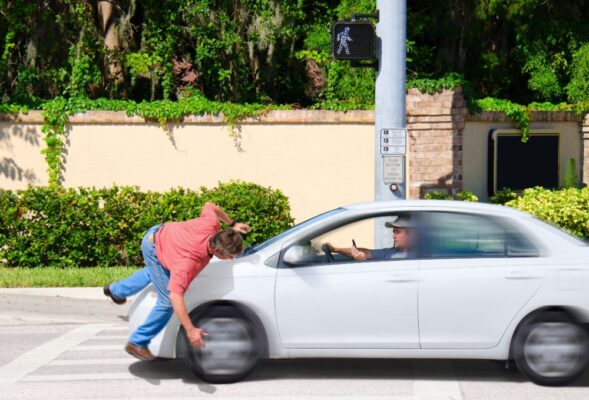Every year, thousands of pedestrians in the state of Georgia are involved in accidents with motor vehicles. These accidents can result in severe injuries or even fatalities. To protect the rights of pedestrians and promote safety on the roads, Georgia has established a set of laws and regulations governing pedestrian accidents. This comprehensive guide will help you understand the key provisions of Georgia’s pedestrian accident laws and what to do if you’re involved in such an incident.
Pedestrian Rights and Responsibilities
Georgia law places a significant emphasis on pedestrian safety and their rights on the road. Here are some fundamental principles:
Crosswalks: Pedestrians have the right of way in marked and unmarked crosswalks at intersections. Drivers must yield to pedestrians in these areas.
Jaywalking: Pedestrians are expected to use crosswalks when available. Crossing the road outside of a crosswalk is permissible only if it does not interfere with the flow of traffic.
Obey Traffic Signals: Pedestrians must obey traffic signals, including pedestrian signals. Cross the road only when the “walk” signal is lit.
Right-of-Way: When crossing a road at a point other than a marked or unmarked crosswalk, pedestrians must yield the right-of-way to vehicles.
Driver Responsibilities
Drivers must adhere to several laws to ensure pedestrian safety:
Yielding Right-of-Way: Drivers must yield the right-of-way to pedestrians in crosswalks. It’s important to exercise caution and be prepared to stop.
Stopping at Crosswalks: When a pedestrian is crossing the road within a marked or unmarked crosswalk, drivers must come to a complete stop.
School Zones: Drivers must exercise extreme caution in school zones and be prepared to stop for pedestrians. Speed limits in school zones are often lower to provide extra safety.
Passing Stopped Vehicles: If a vehicle is stopped at a crosswalk to allow a pedestrian to cross, other vehicles must not pass the stopped vehicle.
Pedestrian Accident Liability
Determining liability in pedestrian accidents can be complex. It’s essential to understand contributory negligence, which is a legal doctrine applied in Georgia. If the pedestrian is found to be more than 50% at fault for the accident, they may not be eligible for compensation. This principle emphasizes the importance of adhering to pedestrian responsibilities.
Compensation for Pedestrian Accidents
If you’re involved in a pedestrian accident and not primarily at fault, you may be entitled to compensation. It’s crucial to consider the following avenues:
Personal Injury Claims: If you’ve sustained injuries due to a driver’s negligence, you can file a personal injury claim. This can help cover medical expenses, lost wages, and pain and suffering.
Uninsured/Underinsured Motorist Coverage: If the driver responsible for the accident does not have sufficient insurance coverage, your own uninsured/underinsured motorist coverage can come into play.
Med-Pay and PIP Coverage: Your own insurance policy may include medical payment coverage (Med-Pay) or personal injury protection (PIP), which can help with medical expenses and other accident-related costs.
Wrongful Death Claims: If a pedestrian accident results in a fatality, the family of the deceased may be able to pursue a wrongful death claim to seek compensation for their loss.
What to Do After a Pedestrian Accident
In the event of a pedestrian accident, it’s crucial to take the following steps:
Seek Medical Attention: Even if your injuries seem minor, seek medical attention. Some injuries may not be immediately apparent.
Contact the Police: Call the police to report the accident. They will create an official accident report, which can be crucial for insurance claims and legal actions.
Collect Evidence: Gather evidence at the accident scene. This can include taking photos, getting witness statements, and exchanging information with the driver involved.
Notify Your Insurance Company: Inform your insurance company about the accident, even if you believe the driver is primarily at fault.
Consult an Attorney: It’s advisable to consult with a personal injury attorney who specializes in pedestrian accidents. They can help you understand your rights and guide you through the legal process.
Pedestrian accidents can be life-altering, and understanding Georgia’s pedestrian accident laws is crucial for safeguarding your rights and seeking appropriate compensation. Remember, safety on the road is a shared responsibility, and by adhering to the laws, both pedestrians and drivers can contribute to a safer and more harmonious coexistence on Georgia’s streets.
How can Princenthal, May & Wilson, LLC help you if you have been in a pedestrian accident in Georgia?
At Princenthal, May & Wilson, LLC, we are dedicated to providing comprehensive legal assistance to individuals who have been involved in pedestrian accidents in Georgia. Our experienced team is committed to helping you navigate the complexities of the legal system and seek the compensation you deserve. Here’s how we can assist you if you’ve been in a pedestrian accident in Georgia:
Legal Experience: Our firm specializes in personal injury law, including pedestrian accidents. We have a deep understanding of Georgia’s pedestrian accident laws and the legal processes involved in pursuing a claim.
Evaluation of Your Case: Our team will conduct a thorough evaluation of your case to determine liability and assess the potential compensation you may be entitled to. We’ll examine the circumstances surrounding the accident and the extent of your injuries.
Negotiation with Insurance Companies: Dealing with insurance companies can be a complex and daunting process. We will handle all negotiations with insurance providers on your behalf to ensure you receive a fair and just settlement for your injuries and damages.
Gathering Evidence: We’ll work diligently to collect evidence to support your claim, such as witness statements, accident reports, medical records, and any other relevant documentation.
Skilled Witnesses: If necessary, we will consult with skilled witnesses, such as accident reconstruction specialists and medical specialists, to strengthen your case and provide a clear understanding of the accident’s impact on your life.
Litigation: In cases where a fair settlement cannot be reached through negotiations, we are prepared to take your case to court. Our experienced trial attorneys will advocate on your behalf to secure the compensation you deserve.
Compassionate Support: We understand the physical, emotional, and financial toll a pedestrian accident can have on your life. Our team is here to provide compassionate support throughout the legal process, offering guidance and advice when you need it most.
Maximizing Compensation: Our primary goal is to ensure you receive the maximum compensation possible for your medical expenses, lost wages, pain and suffering, and any other damages you’ve incurred as a result of the accident.
No Upfront Fees: At Princenthal, May & Wilson, LLC, we work on a contingency fee basis. This means you don’t pay any legal fees unless we win your case. Our commitment is to provide accessible legal representation to those who need it.
If you’ve been in a pedestrian accident in Georgia, you don’t have to face the legal challenges alone. Princenthal, May & Wilson, LLC is here to guide you through the process, protect your rights, and work diligently to secure the compensation you deserve. Our experienced team is ready to stand by your side and fight for justice. Contact us today for a consultation and let us help you on the path to recovery and resolution.

